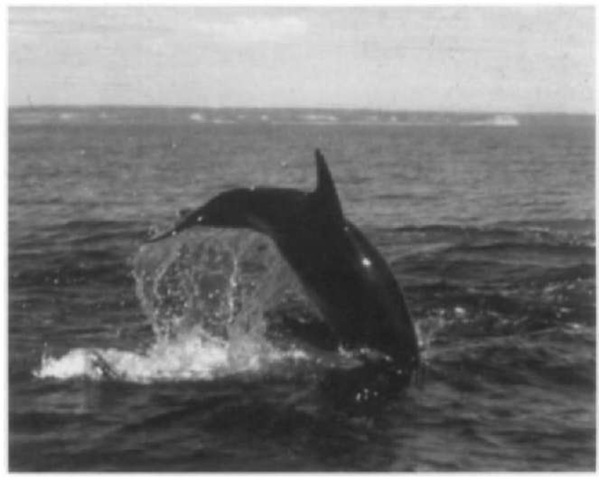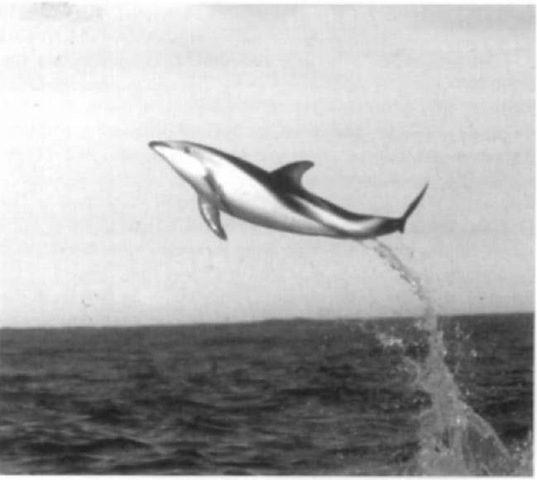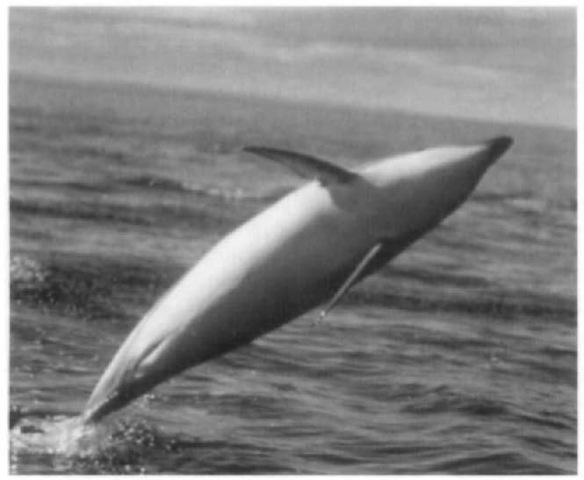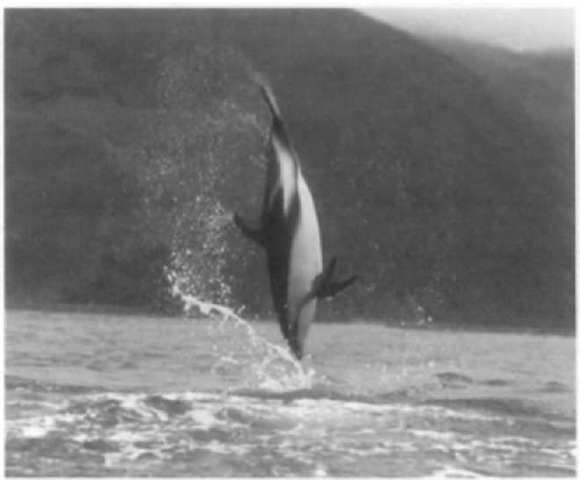Dolphins and whales leap above water in seemingly ex? uberant displays of sheer joy. While play may at times be a cause of leaping, there appear to be multiple leap types and reasons, not totally understood.
When large whales leap, the activity is generally termed breaching. Whales appear to breach to communicate to others, due to a high activity level (or state of alertness), or—at times— from apparent frustration or anger after a social interaction with one or more other whales (Whitehead, 1985). Breaching may also occur for the pure “joy” or “fun” of it, but these potential motivations are difficult for researchers to assess. Leaping by the smaller toothed whales may have similar general functions, as well as several of the more specific ones outlines here.
I. Basic Description
Leaping clear of the water is always an energetic and usually a highly acrobatic feat. First, to clear the water the cetacean needs to attain a rapid forward speed and momentum, near the limit of its swimming capability. It generally bends its body abruptly to exit the water, then twists the body midair to reenter the water in some structured fashion. Even a noisy “belly flop” after a leap has been designed as such, as multiple similar leaps of the same animals demonstrate. Reentering the water can be head first, creating minimal splash and noise. It can consist of a side, back, or belly splash, resulting in a welter of white water and foam and a considerable percussive (splash) noise in-air and underwater. Finally, there is the “showy” acrobatic leap that consists of spins, somersaults, and various in-air twists. Frame-by-frame analysis of high-speed photographs shows that dolphins control these acrobatics to within split-second timing, affecting muscle movements that allow them to perform the same leap and reentry onto the water again and again. In human terms, a well-trained gymnast or pool diver comes to mind. Leaps tend to last for 1 to 2 sec, depending on the acrobatics being performed and the size of the leaping individual.
II. The Head-First Reentry Leap
There are three main variations of this leap that tend to create little water disturbance or noise upon reentry. One consists of a “stationary” leap, where the animal comes steeply from depth, usually greater than three body lengths. It leaps in-air, breathes, and tucks its body into a bend to reorient the head downward, then rapidly descends into depth at or very near the original exit point. This leap appears to be executed for the animal to leave whatever it is doing at depth for a minimal time, breathe, and use the in-air weight of its body to regain its position. The need for such an efficient mechanism to breathe becomes clear when we consider that dolphins feeding or mating at depth, for example, essentially need to interrupt these activities to obtain life-sustaining air. If they can do so rapidly, all the better. The stationary leap is performed singly by dolphins herding food fish below the surface (Wiirsig, 1979), but often in twos or threes during socializing (Norris et al, 1994) (Fig. 1).
A second head-first reentry leap consists of rapid swimming just below the surface, a very abrupt bend of the body to exit the water, and then a long arcuate in-air leap that may propel the dolphin forward by up to three times its own body length. While the reentry is head first, there is nevertheless some splashing of water due to the rapidity of the action, kicked up by the body as it exits and again as it enters. This is the “running leap” of dolphins moving at speed, a form of high porpoising.
Figure 1 A head-first reentry of a dusky dolphin.
Dolphins propel themselves underwater with several powerful but rapid tail beats and then “sail” through the air, a medium 800 times less dense than water. There is considerable drag generated by crossing the air/water interface, but for an animal that needs to come to the surface to breathe anyway (such as penguins and dolphins), travel efficiency increases above a particular speed by leaping rather than swimming. For a 2.5-m-long dolphin, the crossover speed from swimming to leaping is about 4.6 m/sec, or 16.6 km/hr (Au and Weihs, 1980). Above about 4 m body length (and concomitant body weight), high porpoising is no longer as easy, although killer whales (Orcinus orca) moving very rapidly may leap in this manner for short periods of time (Fig. 2).
The third head-first reentry leap is designed to gain height. Dolphins, often in twos or threes, leap as high as three times their own body lengths above the surface of the water, usually but not always reentering the water head first. A 2.5-m male pantropical spotted dolphin (Stenella attenuata)—spotted dolphins are the champion high leapers—thus leaps about 7 m into the air, or the equivalent of over two apartment stories high. While these leaps may be performed largely for “fun,” they may also serve the function of seeing to greater distance by gaining height. Dusky dolphins (Lagenorhynchus obscurus) leap in this fashion just before high porpoising toward feeding aggregations with flocking birds some kilometers away (Wursig and Wursig, 1980) (Fig. 3).
III. The Noisy Leap
When dolphins or whales fall back onto the water with a broad side of the body, they invariably create a large splash and a percussive slap sound. Frame-by-frame analysis of high-speed photography shows that there are actually two splashes: one is created as the animal falls onto the water surface and initiates a crater of water underneath it and the other is the secondary splash (and slap sound) produced as the crater collapses upon itself. This cavitation is particularly dramatic for breaching whales, but is associated with almost all noisy leaps.
Dolphins that noisy-leap exit the water in similar fashion as in head-first reentry leaps, but twist the body to reenter with back, side, or belly first. Many noisy leaps end with the dolphin merely falling back onto the water surface. Others are particularly designed to have the animal reenter in a predetermined fashion, and high-speed photography shows subtle tail, flipper, head, or other body readjustments even split seconds before reentering and appearing to be structured to force the body onto the water with a maximal intensity of splash. These observations have led to speculation that noisy leaps are structured for omni-directional communication among dolphins and whales. Indeed, noisy leaps tend to occur more often in higher wind states (when near-surface ambient noise greatly increases), and this observation fits with the hypothesis of communication. Noisy leaps also occur around the periphery of near-surface schools, and in that case, the percussive slaps, as well as the underwater bubble clouds formed by dolphins reentering the water, may serve to frighten fish and cause them to school or aggregate more tightly. Dolphins may at times also stun or debilitate fish prey with the slaps of noisy leaps (as well as with tail slaps), but there is no detailed information on this possibility (Fig. 4).
Figure 2 Dusky dolphins porpoising.
Figure 3 A high leap of a dusky dolphin.
IV. The Acrobatic Leap
Some dolphins are especially showy for at least some of their leaps, with spins, somersaults, combinations of flips, head twists, extra tail kicks in-air, and so on. These leaps are almost always associated with an obviously high level of social activity in a school or pod, as evidenced by social rubbing, sexual activity, and a cacophony of whistle and other sounds. Acrobatic leaps usually occur in bouts, with one dolphin (or whale) leaping at least several times. The more social the group, the more leaping dolphins and the longer the individual bouts. These leaps appear graceful to our human eyes and appear particularly structured to be enjoyed in the making and the viewing, like art. However, this may not be the case; we simply do not know,
Spinner dolphins (Stenella longirostris) spin by rotating their body rapidly around the long axis up to six times (usually two to four times) before falling back into the water. They do so in both vertical spins and horizontal fashion (Norris and Dohl, 1980). Members of the genus Lagenorhynchus, such as Pacific white-sided (L. obliquidens) and dusky dolphins, are probably the most aerially acrobatic of all dolphins and whales, with somersaults, twists, and various inventive bends and contortions (Brownell and Cipriano, 1999). Individuals also have the longest bouts of any of the dolphins (some whale breach bouts are as long), with up to 36 somersaults having been counted in one dolphin in one about 5-min duration. Interestingly, Lagenorhynchus spp. individuals will “never” change leap type during a bout. If a dusky dolphin begins a backwards somersault with a half twist to the left and a tail kick just before reentering the water, it will continue this same leap, with absolutely no noticeable variation, during that leap bout. Toward the end of the bout, it will tire, muscle action will slow, and the leap will be slightly imperfect. It then quits and breathes while resting at the surface for several minutes. Later, in a different bout, the same individual will leap differently, demonstrating that it knows more than one leap type.
Figure 4 A side slap of a dusky dolphin.
Acrobatic leaps tend to be noisy, but are not structured specifically to make noise. They are structured to be acrobatic, and it is difficult to imagine that they occur for anything but the “fun” (or the art) of it. A more scientifically acceptable explanation may be that acrobatic leaps are not merely an outgrowth of a high level of social activity, but are themselves a call for social activity. Acrobatic leap types may thus serve a social facilitation function that helps to coordinate members of a school or pod. Such facilitation may be especially useful to animals that coordinate finding and aggregating of food and that may need to establish and maintain delicate balances of social and sexual hierarchies. One argument against this stands out: dolphins leaping acrobatically are not being watched by others. They perform their show above the surface while, at any one time of a leap, most or all others are below. Acrobatic leaps may create somewhat different splash sounds from other more simple leaps, but this is not known (Figs. 5 and 6).
Figure 5 A spinner dolphin spinning.
V. Conclusions
The descriptions in this article are not to be thought of as complete explanations of the various—and variable—leaps of cetaceans. There is much that we do not yet know, but it is certainly fair to say that surface-active cetaceans, being large-brained social mammals, may have many different reasons for their actions. One long-existing guess for leaping may have some truth to it as well. This is the suggestion that leaping, and die attendant splashing onto the water’s surface, may be an attempt to dislodge parasites or other biological hitchhikers. Indeed, there is evidence for Hawaiian spinner dolphins, that individuals with re-moras attached to their sides or bellies leap more than those that do not, and the author has seen remoras fly off spinning spinner dolphins, even before the dolphins hit the water. To get rid of potentially bothersome (and drag-inducing) freeloaders may be a partial explanation, but it cannot be the entire explanation. Leaping occui”s for a variety of reasons, having to do with locomotion.
Figure 6 A dusky dolphin somersaulting.
A discussion of leaping would be incomplete without mention of other than cetacean marine mammals. Indeed, otariid pinnipeds also high-porpoise (probably for the same hydrody-namic efficiency consideration as for dolphins), and especially fur seals and sea otters leap at the surface by rapidly rolling around their own axes. This activity serves to aerate the extremely fine, long, and dense pelage of these marine mammals that use air for insulation. Leaping in pinnipeds and sea otters at times may also consist of play activity, but there is no further information on this point.






